International Business Analysis: Myanmar Phone Industry Report
VerifiedAdded on 2020/05/28
|17
|5460
|238
Report
AI Summary
This report provides an in-depth analysis of the international business environment of Myanmar's phone industry. It begins by applying Porter's Diamond Model to assess the industry's competitiveness, examining demand conditions, factor endowments, related industries, firm strategy, government influence, and chance events. The report then explores the advantages and disadvantages of Greenfield investments in this context. Finally, it addresses contemporary management issues, specifically lawful interceptions and land and labor rights within the Myanmar phone industry. The analysis considers the rapid growth and unique characteristics of the market, including the impact of government policies, technological advancements, and the evolving competitive landscape. This comprehensive overview provides valuable insights into the challenges and opportunities within Myanmar's mobile phone sector.
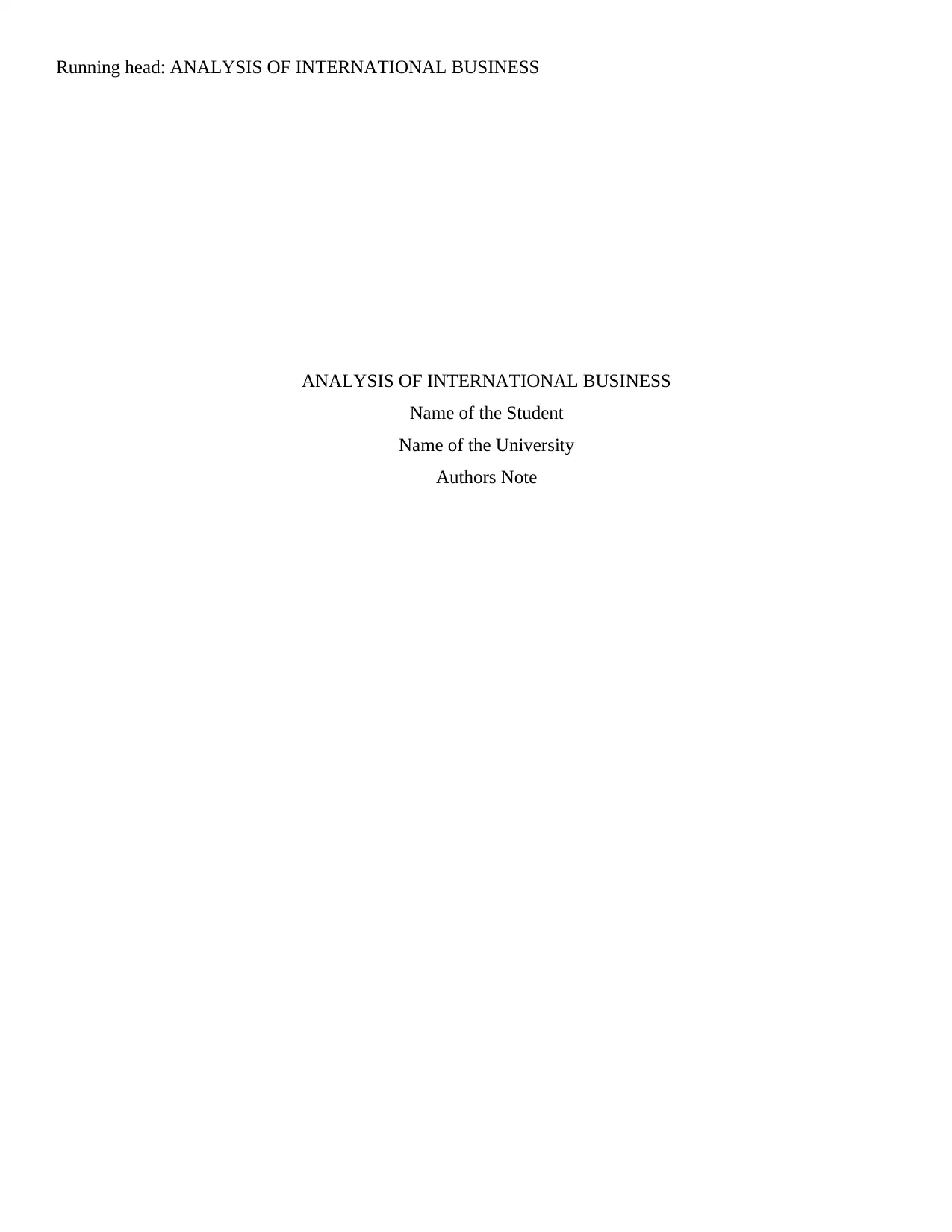
Running head: ANALYSIS OF INTERNATIONAL BUSINESS
ANALYSIS OF INTERNATIONAL BUSINESS
Name of the Student
Name of the University
Authors Note
ANALYSIS OF INTERNATIONAL BUSINESS
Name of the Student
Name of the University
Authors Note
Paraphrase This Document
Need a fresh take? Get an instant paraphrase of this document with our AI Paraphraser
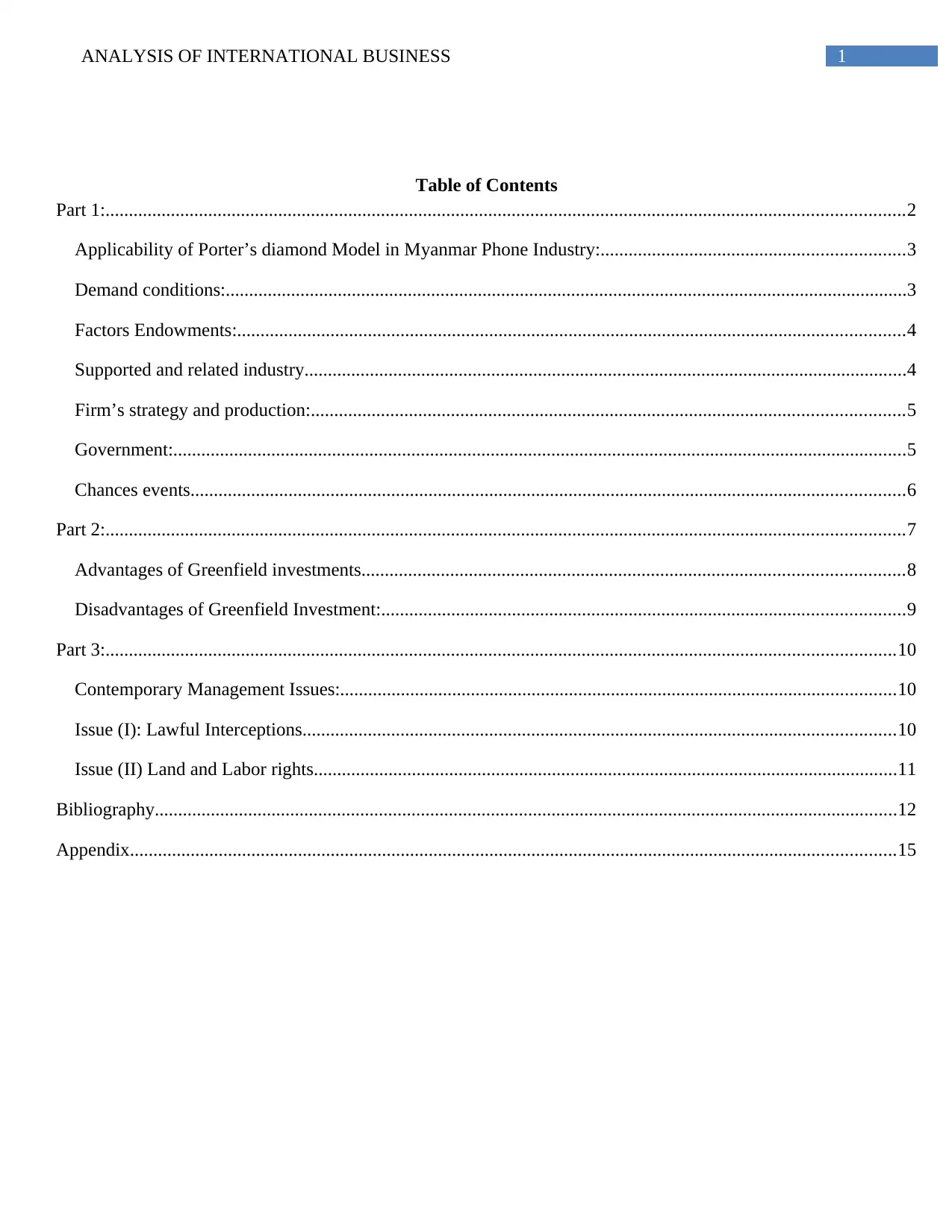
1ANALYSIS OF INTERNATIONAL BUSINESS
Table of Contents
Part 1:...........................................................................................................................................................................2
Applicability of Porter’s diamond Model in Myanmar Phone Industry:.................................................................3
Demand conditions:..................................................................................................................................................3
Factors Endowments:...............................................................................................................................................4
Supported and related industry.................................................................................................................................4
Firm’s strategy and production:...............................................................................................................................5
Government:.............................................................................................................................................................5
Chances events.........................................................................................................................................................6
Part 2:...........................................................................................................................................................................7
Advantages of Greenfield investments....................................................................................................................8
Disadvantages of Greenfield Investment:................................................................................................................9
Part 3:.........................................................................................................................................................................10
Contemporary Management Issues:.......................................................................................................................10
Issue (I): Lawful Interceptions...............................................................................................................................10
Issue (II) Land and Labor rights.............................................................................................................................11
Bibliography...............................................................................................................................................................12
Appendix....................................................................................................................................................................15
Table of Contents
Part 1:...........................................................................................................................................................................2
Applicability of Porter’s diamond Model in Myanmar Phone Industry:.................................................................3
Demand conditions:..................................................................................................................................................3
Factors Endowments:...............................................................................................................................................4
Supported and related industry.................................................................................................................................4
Firm’s strategy and production:...............................................................................................................................5
Government:.............................................................................................................................................................5
Chances events.........................................................................................................................................................6
Part 2:...........................................................................................................................................................................7
Advantages of Greenfield investments....................................................................................................................8
Disadvantages of Greenfield Investment:................................................................................................................9
Part 3:.........................................................................................................................................................................10
Contemporary Management Issues:.......................................................................................................................10
Issue (I): Lawful Interceptions...............................................................................................................................10
Issue (II) Land and Labor rights.............................................................................................................................11
Bibliography...............................................................................................................................................................12
Appendix....................................................................................................................................................................15
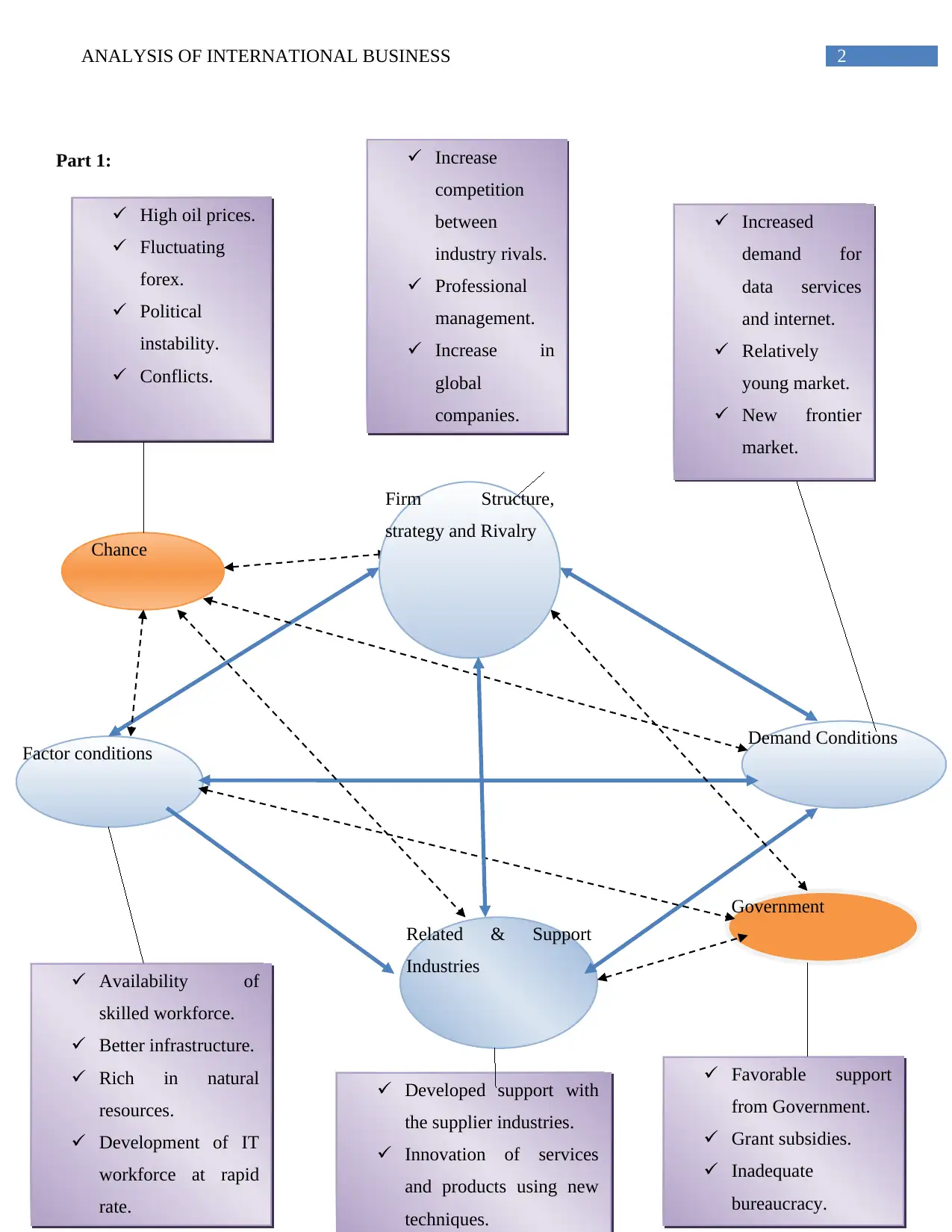
2ANALYSIS OF INTERNATIONAL BUSINESS
Part 1:
Demand Conditions
Factor conditions
Related & Support
Industries
Chance
Government
Firm Structure,
strategy and Rivalry
High oil prices.
Fluctuating
forex.
Political
instability.
Conflicts.
Increase
competition
between
industry rivals.
Professional
management.
Increase in
global
companies.
Increased
demand for
data services
and internet.
Relatively
young market.
New frontier
market.
Availability of
skilled workforce.
Better infrastructure.
Rich in natural
resources.
Development of IT
workforce at rapid
rate.
Developed support with
the supplier industries.
Innovation of services
and products using new
techniques.
Favorable support
from Government.
Grant subsidies.
Inadequate
bureaucracy.
Part 1:
Demand Conditions
Factor conditions
Related & Support
Industries
Chance
Government
Firm Structure,
strategy and Rivalry
High oil prices.
Fluctuating
forex.
Political
instability.
Conflicts.
Increase
competition
between
industry rivals.
Professional
management.
Increase in
global
companies.
Increased
demand for
data services
and internet.
Relatively
young market.
New frontier
market.
Availability of
skilled workforce.
Better infrastructure.
Rich in natural
resources.
Development of IT
workforce at rapid
rate.
Developed support with
the supplier industries.
Innovation of services
and products using new
techniques.
Favorable support
from Government.
Grant subsidies.
Inadequate
bureaucracy.
⊘ This is a preview!⊘
Do you want full access?
Subscribe today to unlock all pages.

Trusted by 1+ million students worldwide
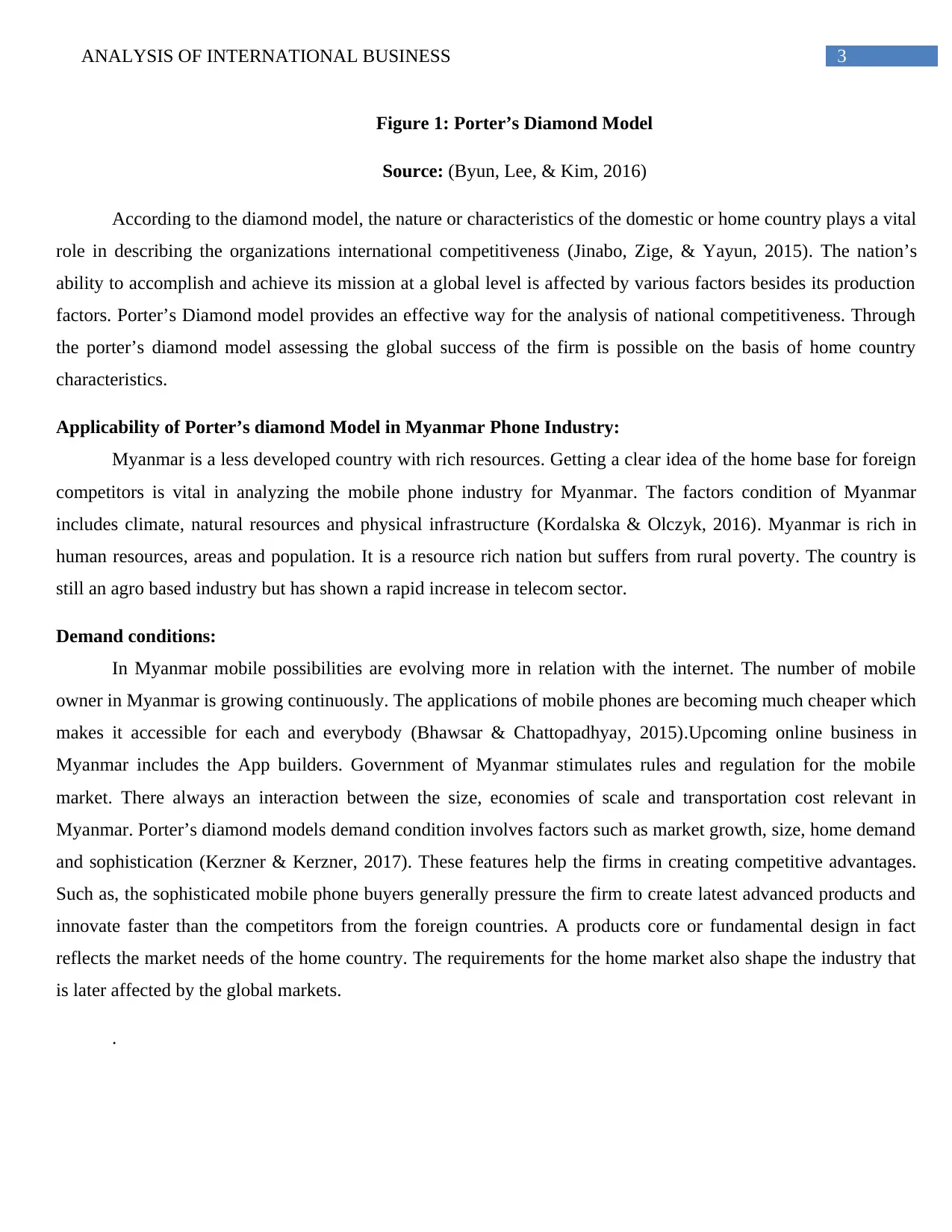
3ANALYSIS OF INTERNATIONAL BUSINESS
Figure 1: Porter’s Diamond Model
Source: (Byun, Lee, & Kim, 2016)
According to the diamond model, the nature or characteristics of the domestic or home country plays a vital
role in describing the organizations international competitiveness (Jinabo, Zige, & Yayun, 2015). The nation’s
ability to accomplish and achieve its mission at a global level is affected by various factors besides its production
factors. Porter’s Diamond model provides an effective way for the analysis of national competitiveness. Through
the porter’s diamond model assessing the global success of the firm is possible on the basis of home country
characteristics.
Applicability of Porter’s diamond Model in Myanmar Phone Industry:
Myanmar is a less developed country with rich resources. Getting a clear idea of the home base for foreign
competitors is vital in analyzing the mobile phone industry for Myanmar. The factors condition of Myanmar
includes climate, natural resources and physical infrastructure (Kordalska & Olczyk, 2016). Myanmar is rich in
human resources, areas and population. It is a resource rich nation but suffers from rural poverty. The country is
still an agro based industry but has shown a rapid increase in telecom sector.
Demand conditions:
In Myanmar mobile possibilities are evolving more in relation with the internet. The number of mobile
owner in Myanmar is growing continuously. The applications of mobile phones are becoming much cheaper which
makes it accessible for each and everybody (Bhawsar & Chattopadhyay, 2015).Upcoming online business in
Myanmar includes the App builders. Government of Myanmar stimulates rules and regulation for the mobile
market. There always an interaction between the size, economies of scale and transportation cost relevant in
Myanmar. Porter’s diamond models demand condition involves factors such as market growth, size, home demand
and sophistication (Kerzner & Kerzner, 2017). These features help the firms in creating competitive advantages.
Such as, the sophisticated mobile phone buyers generally pressure the firm to create latest advanced products and
innovate faster than the competitors from the foreign countries. A products core or fundamental design in fact
reflects the market needs of the home country. The requirements for the home market also shape the industry that
is later affected by the global markets.
.
Figure 1: Porter’s Diamond Model
Source: (Byun, Lee, & Kim, 2016)
According to the diamond model, the nature or characteristics of the domestic or home country plays a vital
role in describing the organizations international competitiveness (Jinabo, Zige, & Yayun, 2015). The nation’s
ability to accomplish and achieve its mission at a global level is affected by various factors besides its production
factors. Porter’s Diamond model provides an effective way for the analysis of national competitiveness. Through
the porter’s diamond model assessing the global success of the firm is possible on the basis of home country
characteristics.
Applicability of Porter’s diamond Model in Myanmar Phone Industry:
Myanmar is a less developed country with rich resources. Getting a clear idea of the home base for foreign
competitors is vital in analyzing the mobile phone industry for Myanmar. The factors condition of Myanmar
includes climate, natural resources and physical infrastructure (Kordalska & Olczyk, 2016). Myanmar is rich in
human resources, areas and population. It is a resource rich nation but suffers from rural poverty. The country is
still an agro based industry but has shown a rapid increase in telecom sector.
Demand conditions:
In Myanmar mobile possibilities are evolving more in relation with the internet. The number of mobile
owner in Myanmar is growing continuously. The applications of mobile phones are becoming much cheaper which
makes it accessible for each and everybody (Bhawsar & Chattopadhyay, 2015).Upcoming online business in
Myanmar includes the App builders. Government of Myanmar stimulates rules and regulation for the mobile
market. There always an interaction between the size, economies of scale and transportation cost relevant in
Myanmar. Porter’s diamond models demand condition involves factors such as market growth, size, home demand
and sophistication (Kerzner & Kerzner, 2017). These features help the firms in creating competitive advantages.
Such as, the sophisticated mobile phone buyers generally pressure the firm to create latest advanced products and
innovate faster than the competitors from the foreign countries. A products core or fundamental design in fact
reflects the market needs of the home country. The requirements for the home market also shape the industry that
is later affected by the global markets.
.
Paraphrase This Document
Need a fresh take? Get an instant paraphrase of this document with our AI Paraphraser
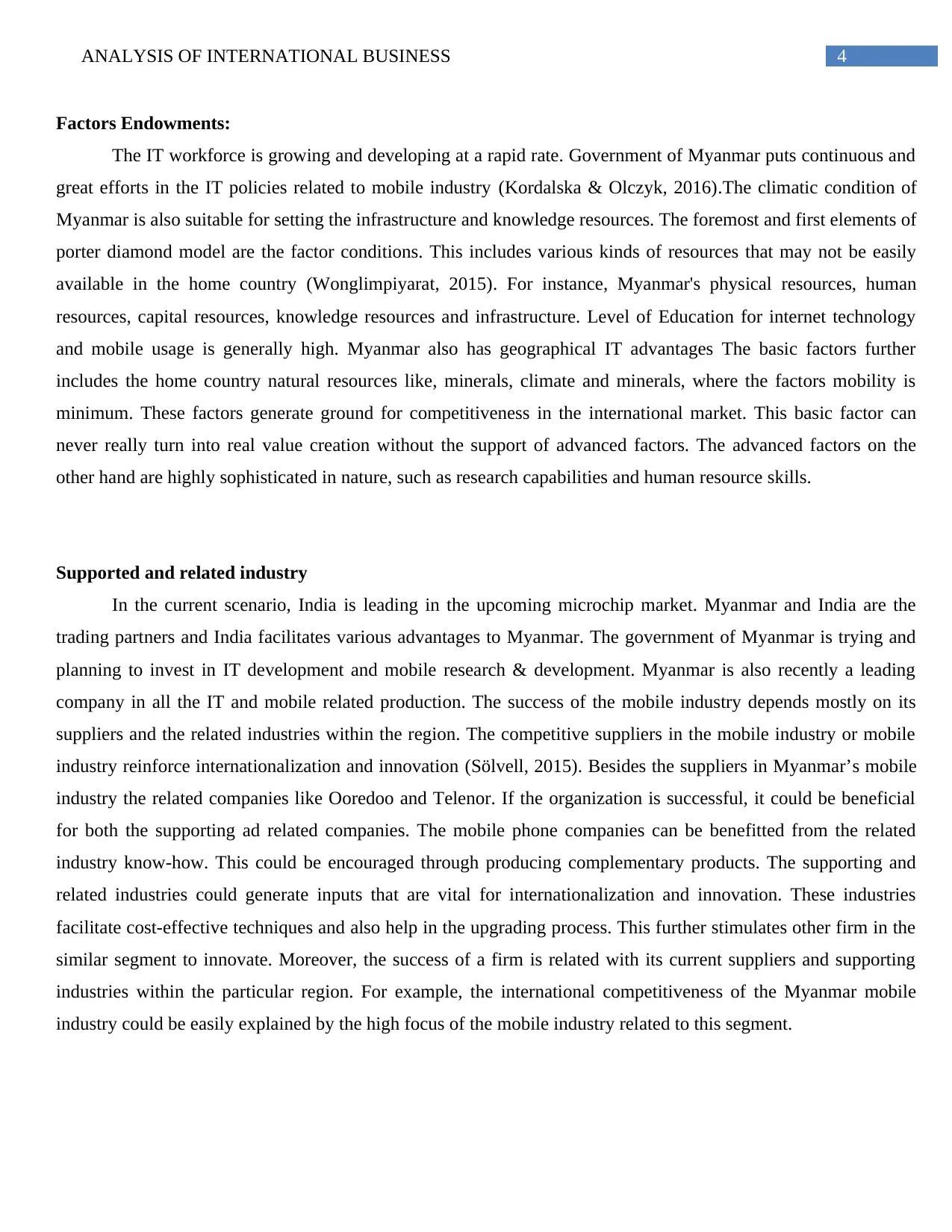
4ANALYSIS OF INTERNATIONAL BUSINESS
Factors Endowments:
The IT workforce is growing and developing at a rapid rate. Government of Myanmar puts continuous and
great efforts in the IT policies related to mobile industry (Kordalska & Olczyk, 2016).The climatic condition of
Myanmar is also suitable for setting the infrastructure and knowledge resources. The foremost and first elements of
porter diamond model are the factor conditions. This includes various kinds of resources that may not be easily
available in the home country (Wonglimpiyarat, 2015). For instance, Myanmar's physical resources, human
resources, capital resources, knowledge resources and infrastructure. Level of Education for internet technology
and mobile usage is generally high. Myanmar also has geographical IT advantages The basic factors further
includes the home country natural resources like, minerals, climate and minerals, where the factors mobility is
minimum. These factors generate ground for competitiveness in the international market. This basic factor can
never really turn into real value creation without the support of advanced factors. The advanced factors on the
other hand are highly sophisticated in nature, such as research capabilities and human resource skills.
Supported and related industry
In the current scenario, India is leading in the upcoming microchip market. Myanmar and India are the
trading partners and India facilitates various advantages to Myanmar. The government of Myanmar is trying and
planning to invest in IT development and mobile research & development. Myanmar is also recently a leading
company in all the IT and mobile related production. The success of the mobile industry depends mostly on its
suppliers and the related industries within the region. The competitive suppliers in the mobile industry or mobile
industry reinforce internationalization and innovation (Sölvell, 2015). Besides the suppliers in Myanmar’s mobile
industry the related companies like Ooredoo and Telenor. If the organization is successful, it could be beneficial
for both the supporting ad related companies. The mobile phone companies can be benefitted from the related
industry know-how. This could be encouraged through producing complementary products. The supporting and
related industries could generate inputs that are vital for internationalization and innovation. These industries
facilitate cost-effective techniques and also help in the upgrading process. This further stimulates other firm in the
similar segment to innovate. Moreover, the success of a firm is related with its current suppliers and supporting
industries within the particular region. For example, the international competitiveness of the Myanmar mobile
industry could be easily explained by the high focus of the mobile industry related to this segment.
Factors Endowments:
The IT workforce is growing and developing at a rapid rate. Government of Myanmar puts continuous and
great efforts in the IT policies related to mobile industry (Kordalska & Olczyk, 2016).The climatic condition of
Myanmar is also suitable for setting the infrastructure and knowledge resources. The foremost and first elements of
porter diamond model are the factor conditions. This includes various kinds of resources that may not be easily
available in the home country (Wonglimpiyarat, 2015). For instance, Myanmar's physical resources, human
resources, capital resources, knowledge resources and infrastructure. Level of Education for internet technology
and mobile usage is generally high. Myanmar also has geographical IT advantages The basic factors further
includes the home country natural resources like, minerals, climate and minerals, where the factors mobility is
minimum. These factors generate ground for competitiveness in the international market. This basic factor can
never really turn into real value creation without the support of advanced factors. The advanced factors on the
other hand are highly sophisticated in nature, such as research capabilities and human resource skills.
Supported and related industry
In the current scenario, India is leading in the upcoming microchip market. Myanmar and India are the
trading partners and India facilitates various advantages to Myanmar. The government of Myanmar is trying and
planning to invest in IT development and mobile research & development. Myanmar is also recently a leading
company in all the IT and mobile related production. The success of the mobile industry depends mostly on its
suppliers and the related industries within the region. The competitive suppliers in the mobile industry or mobile
industry reinforce internationalization and innovation (Sölvell, 2015). Besides the suppliers in Myanmar’s mobile
industry the related companies like Ooredoo and Telenor. If the organization is successful, it could be beneficial
for both the supporting ad related companies. The mobile phone companies can be benefitted from the related
industry know-how. This could be encouraged through producing complementary products. The supporting and
related industries could generate inputs that are vital for internationalization and innovation. These industries
facilitate cost-effective techniques and also help in the upgrading process. This further stimulates other firm in the
similar segment to innovate. Moreover, the success of a firm is related with its current suppliers and supporting
industries within the particular region. For example, the international competitiveness of the Myanmar mobile
industry could be easily explained by the high focus of the mobile industry related to this segment.
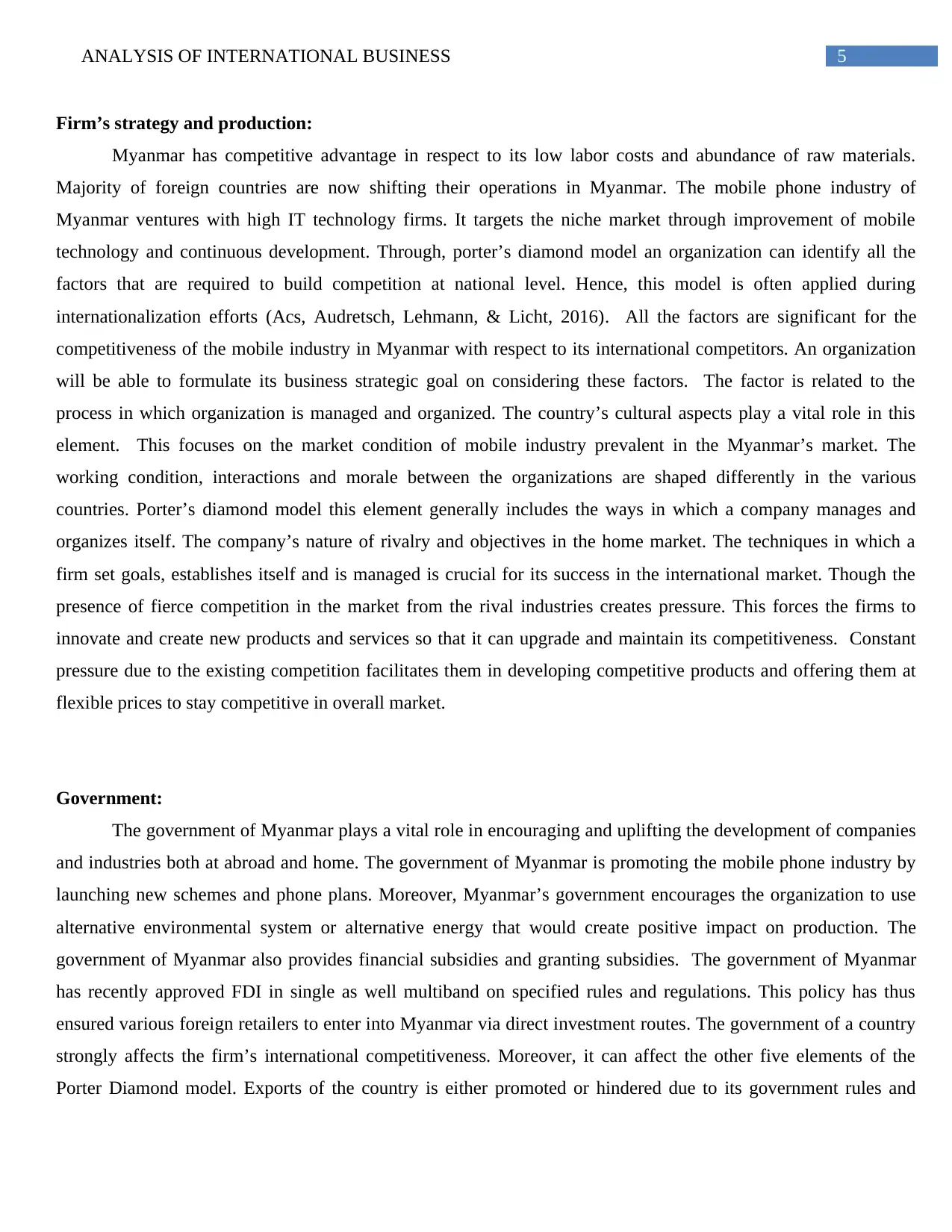
5ANALYSIS OF INTERNATIONAL BUSINESS
Firm’s strategy and production:
Myanmar has competitive advantage in respect to its low labor costs and abundance of raw materials.
Majority of foreign countries are now shifting their operations in Myanmar. The mobile phone industry of
Myanmar ventures with high IT technology firms. It targets the niche market through improvement of mobile
technology and continuous development. Through, porter’s diamond model an organization can identify all the
factors that are required to build competition at national level. Hence, this model is often applied during
internationalization efforts (Acs, Audretsch, Lehmann, & Licht, 2016). All the factors are significant for the
competitiveness of the mobile industry in Myanmar with respect to its international competitors. An organization
will be able to formulate its business strategic goal on considering these factors. The factor is related to the
process in which organization is managed and organized. The country’s cultural aspects play a vital role in this
element. This focuses on the market condition of mobile industry prevalent in the Myanmar’s market. The
working condition, interactions and morale between the organizations are shaped differently in the various
countries. Porter’s diamond model this element generally includes the ways in which a company manages and
organizes itself. The company’s nature of rivalry and objectives in the home market. The techniques in which a
firm set goals, establishes itself and is managed is crucial for its success in the international market. Though the
presence of fierce competition in the market from the rival industries creates pressure. This forces the firms to
innovate and create new products and services so that it can upgrade and maintain its competitiveness. Constant
pressure due to the existing competition facilitates them in developing competitive products and offering them at
flexible prices to stay competitive in overall market.
Government:
The government of Myanmar plays a vital role in encouraging and uplifting the development of companies
and industries both at abroad and home. The government of Myanmar is promoting the mobile phone industry by
launching new schemes and phone plans. Moreover, Myanmar’s government encourages the organization to use
alternative environmental system or alternative energy that would create positive impact on production. The
government of Myanmar also provides financial subsidies and granting subsidies. The government of Myanmar
has recently approved FDI in single as well multiband on specified rules and regulations. This policy has thus
ensured various foreign retailers to enter into Myanmar via direct investment routes. The government of a country
strongly affects the firm’s international competitiveness. Moreover, it can affect the other five elements of the
Porter Diamond model. Exports of the country is either promoted or hindered due to its government rules and
Firm’s strategy and production:
Myanmar has competitive advantage in respect to its low labor costs and abundance of raw materials.
Majority of foreign countries are now shifting their operations in Myanmar. The mobile phone industry of
Myanmar ventures with high IT technology firms. It targets the niche market through improvement of mobile
technology and continuous development. Through, porter’s diamond model an organization can identify all the
factors that are required to build competition at national level. Hence, this model is often applied during
internationalization efforts (Acs, Audretsch, Lehmann, & Licht, 2016). All the factors are significant for the
competitiveness of the mobile industry in Myanmar with respect to its international competitors. An organization
will be able to formulate its business strategic goal on considering these factors. The factor is related to the
process in which organization is managed and organized. The country’s cultural aspects play a vital role in this
element. This focuses on the market condition of mobile industry prevalent in the Myanmar’s market. The
working condition, interactions and morale between the organizations are shaped differently in the various
countries. Porter’s diamond model this element generally includes the ways in which a company manages and
organizes itself. The company’s nature of rivalry and objectives in the home market. The techniques in which a
firm set goals, establishes itself and is managed is crucial for its success in the international market. Though the
presence of fierce competition in the market from the rival industries creates pressure. This forces the firms to
innovate and create new products and services so that it can upgrade and maintain its competitiveness. Constant
pressure due to the existing competition facilitates them in developing competitive products and offering them at
flexible prices to stay competitive in overall market.
Government:
The government of Myanmar plays a vital role in encouraging and uplifting the development of companies
and industries both at abroad and home. The government of Myanmar is promoting the mobile phone industry by
launching new schemes and phone plans. Moreover, Myanmar’s government encourages the organization to use
alternative environmental system or alternative energy that would create positive impact on production. The
government of Myanmar also provides financial subsidies and granting subsidies. The government of Myanmar
has recently approved FDI in single as well multiband on specified rules and regulations. This policy has thus
ensured various foreign retailers to enter into Myanmar via direct investment routes. The government of a country
strongly affects the firm’s international competitiveness. Moreover, it can affect the other five elements of the
Porter Diamond model. Exports of the country is either promoted or hindered due to its government rules and
⊘ This is a preview!⊘
Do you want full access?
Subscribe today to unlock all pages.

Trusted by 1+ million students worldwide
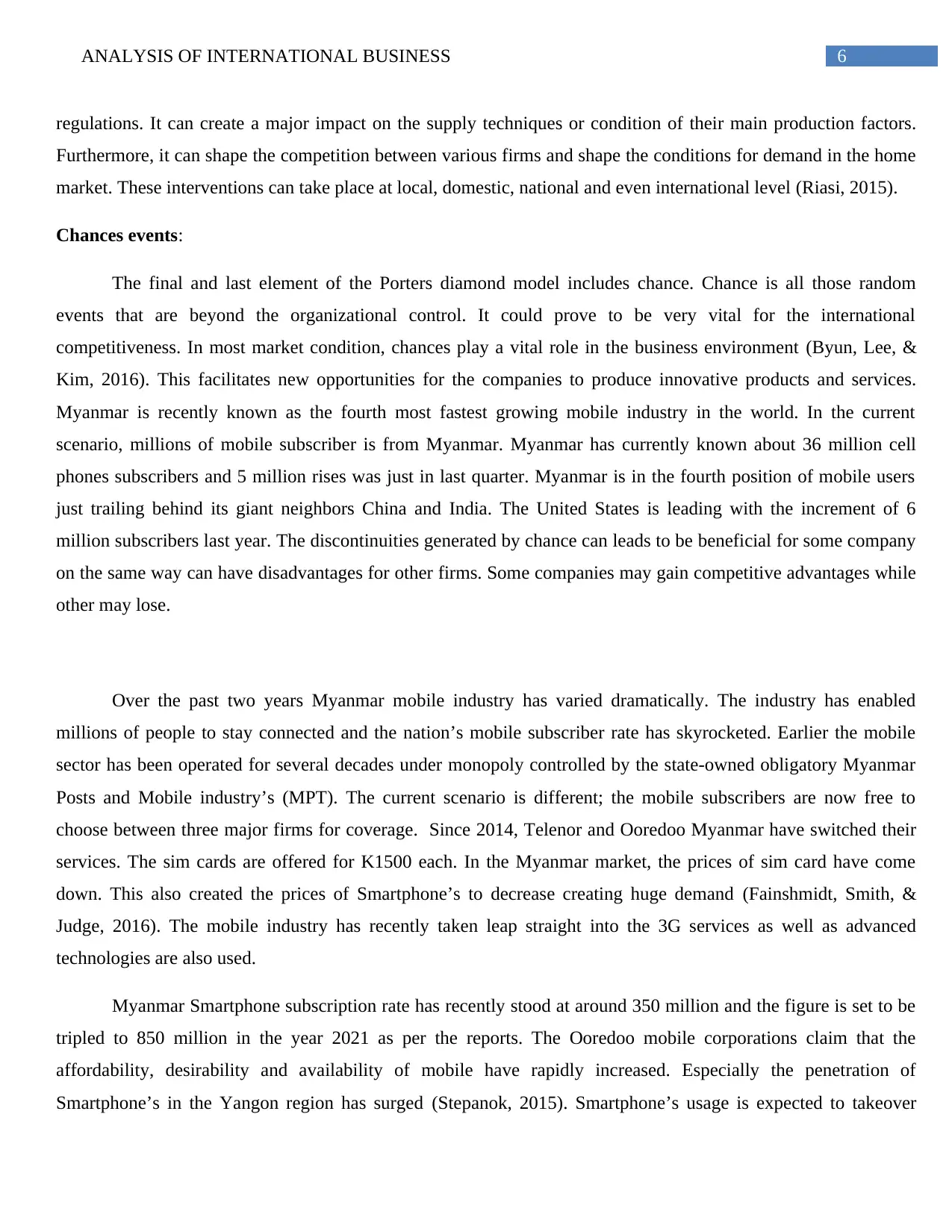
6ANALYSIS OF INTERNATIONAL BUSINESS
regulations. It can create a major impact on the supply techniques or condition of their main production factors.
Furthermore, it can shape the competition between various firms and shape the conditions for demand in the home
market. These interventions can take place at local, domestic, national and even international level (Riasi, 2015).
Chances events:
The final and last element of the Porters diamond model includes chance. Chance is all those random
events that are beyond the organizational control. It could prove to be very vital for the international
competitiveness. In most market condition, chances play a vital role in the business environment (Byun, Lee, &
Kim, 2016). This facilitates new opportunities for the companies to produce innovative products and services.
Myanmar is recently known as the fourth most fastest growing mobile industry in the world. In the current
scenario, millions of mobile subscriber is from Myanmar. Myanmar has currently known about 36 million cell
phones subscribers and 5 million rises was just in last quarter. Myanmar is in the fourth position of mobile users
just trailing behind its giant neighbors China and India. The United States is leading with the increment of 6
million subscribers last year. The discontinuities generated by chance can leads to be beneficial for some company
on the same way can have disadvantages for other firms. Some companies may gain competitive advantages while
other may lose.
Over the past two years Myanmar mobile industry has varied dramatically. The industry has enabled
millions of people to stay connected and the nation’s mobile subscriber rate has skyrocketed. Earlier the mobile
sector has been operated for several decades under monopoly controlled by the state-owned obligatory Myanmar
Posts and Mobile industry’s (MPT). The current scenario is different; the mobile subscribers are now free to
choose between three major firms for coverage. Since 2014, Telenor and Ooredoo Myanmar have switched their
services. The sim cards are offered for K1500 each. In the Myanmar market, the prices of sim card have come
down. This also created the prices of Smartphone’s to decrease creating huge demand (Fainshmidt, Smith, &
Judge, 2016). The mobile industry has recently taken leap straight into the 3G services as well as advanced
technologies are also used.
Myanmar Smartphone subscription rate has recently stood at around 350 million and the figure is set to be
tripled to 850 million in the year 2021 as per the reports. The Ooredoo mobile corporations claim that the
affordability, desirability and availability of mobile have rapidly increased. Especially the penetration of
Smartphone’s in the Yangon region has surged (Stepanok, 2015). Smartphone’s usage is expected to takeover
regulations. It can create a major impact on the supply techniques or condition of their main production factors.
Furthermore, it can shape the competition between various firms and shape the conditions for demand in the home
market. These interventions can take place at local, domestic, national and even international level (Riasi, 2015).
Chances events:
The final and last element of the Porters diamond model includes chance. Chance is all those random
events that are beyond the organizational control. It could prove to be very vital for the international
competitiveness. In most market condition, chances play a vital role in the business environment (Byun, Lee, &
Kim, 2016). This facilitates new opportunities for the companies to produce innovative products and services.
Myanmar is recently known as the fourth most fastest growing mobile industry in the world. In the current
scenario, millions of mobile subscriber is from Myanmar. Myanmar has currently known about 36 million cell
phones subscribers and 5 million rises was just in last quarter. Myanmar is in the fourth position of mobile users
just trailing behind its giant neighbors China and India. The United States is leading with the increment of 6
million subscribers last year. The discontinuities generated by chance can leads to be beneficial for some company
on the same way can have disadvantages for other firms. Some companies may gain competitive advantages while
other may lose.
Over the past two years Myanmar mobile industry has varied dramatically. The industry has enabled
millions of people to stay connected and the nation’s mobile subscriber rate has skyrocketed. Earlier the mobile
sector has been operated for several decades under monopoly controlled by the state-owned obligatory Myanmar
Posts and Mobile industry’s (MPT). The current scenario is different; the mobile subscribers are now free to
choose between three major firms for coverage. Since 2014, Telenor and Ooredoo Myanmar have switched their
services. The sim cards are offered for K1500 each. In the Myanmar market, the prices of sim card have come
down. This also created the prices of Smartphone’s to decrease creating huge demand (Fainshmidt, Smith, &
Judge, 2016). The mobile industry has recently taken leap straight into the 3G services as well as advanced
technologies are also used.
Myanmar Smartphone subscription rate has recently stood at around 350 million and the figure is set to be
tripled to 850 million in the year 2021 as per the reports. The Ooredoo mobile corporations claim that the
affordability, desirability and availability of mobile have rapidly increased. Especially the penetration of
Smartphone’s in the Yangon region has surged (Stepanok, 2015). Smartphone’s usage is expected to takeover
Paraphrase This Document
Need a fresh take? Get an instant paraphrase of this document with our AI Paraphraser
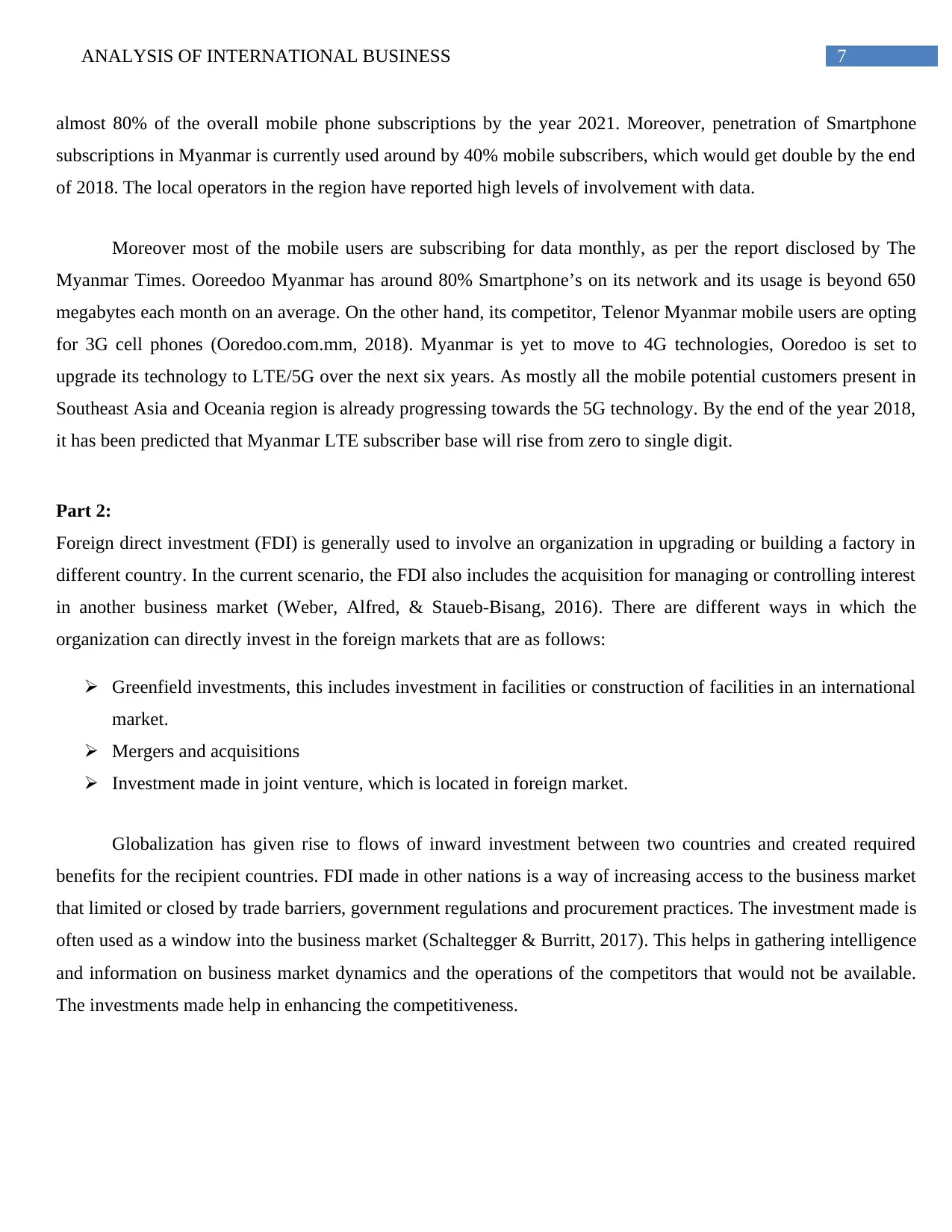
7ANALYSIS OF INTERNATIONAL BUSINESS
almost 80% of the overall mobile phone subscriptions by the year 2021. Moreover, penetration of Smartphone
subscriptions in Myanmar is currently used around by 40% mobile subscribers, which would get double by the end
of 2018. The local operators in the region have reported high levels of involvement with data.
Moreover most of the mobile users are subscribing for data monthly, as per the report disclosed by The
Myanmar Times. Ooreedoo Myanmar has around 80% Smartphone’s on its network and its usage is beyond 650
megabytes each month on an average. On the other hand, its competitor, Telenor Myanmar mobile users are opting
for 3G cell phones (Ooredoo.com.mm, 2018). Myanmar is yet to move to 4G technologies, Ooredoo is set to
upgrade its technology to LTE/5G over the next six years. As mostly all the mobile potential customers present in
Southeast Asia and Oceania region is already progressing towards the 5G technology. By the end of the year 2018,
it has been predicted that Myanmar LTE subscriber base will rise from zero to single digit.
Part 2:
Foreign direct investment (FDI) is generally used to involve an organization in upgrading or building a factory in
different country. In the current scenario, the FDI also includes the acquisition for managing or controlling interest
in another business market (Weber, Alfred, & Staueb-Bisang, 2016). There are different ways in which the
organization can directly invest in the foreign markets that are as follows:
Greenfield investments, this includes investment in facilities or construction of facilities in an international
market.
Mergers and acquisitions
Investment made in joint venture, which is located in foreign market.
Globalization has given rise to flows of inward investment between two countries and created required
benefits for the recipient countries. FDI made in other nations is a way of increasing access to the business market
that limited or closed by trade barriers, government regulations and procurement practices. The investment made is
often used as a window into the business market (Schaltegger & Burritt, 2017). This helps in gathering intelligence
and information on business market dynamics and the operations of the competitors that would not be available.
The investments made help in enhancing the competitiveness.
almost 80% of the overall mobile phone subscriptions by the year 2021. Moreover, penetration of Smartphone
subscriptions in Myanmar is currently used around by 40% mobile subscribers, which would get double by the end
of 2018. The local operators in the region have reported high levels of involvement with data.
Moreover most of the mobile users are subscribing for data monthly, as per the report disclosed by The
Myanmar Times. Ooreedoo Myanmar has around 80% Smartphone’s on its network and its usage is beyond 650
megabytes each month on an average. On the other hand, its competitor, Telenor Myanmar mobile users are opting
for 3G cell phones (Ooredoo.com.mm, 2018). Myanmar is yet to move to 4G technologies, Ooredoo is set to
upgrade its technology to LTE/5G over the next six years. As mostly all the mobile potential customers present in
Southeast Asia and Oceania region is already progressing towards the 5G technology. By the end of the year 2018,
it has been predicted that Myanmar LTE subscriber base will rise from zero to single digit.
Part 2:
Foreign direct investment (FDI) is generally used to involve an organization in upgrading or building a factory in
different country. In the current scenario, the FDI also includes the acquisition for managing or controlling interest
in another business market (Weber, Alfred, & Staueb-Bisang, 2016). There are different ways in which the
organization can directly invest in the foreign markets that are as follows:
Greenfield investments, this includes investment in facilities or construction of facilities in an international
market.
Mergers and acquisitions
Investment made in joint venture, which is located in foreign market.
Globalization has given rise to flows of inward investment between two countries and created required
benefits for the recipient countries. FDI made in other nations is a way of increasing access to the business market
that limited or closed by trade barriers, government regulations and procurement practices. The investment made is
often used as a window into the business market (Schaltegger & Burritt, 2017). This helps in gathering intelligence
and information on business market dynamics and the operations of the competitors that would not be available.
The investments made help in enhancing the competitiveness.
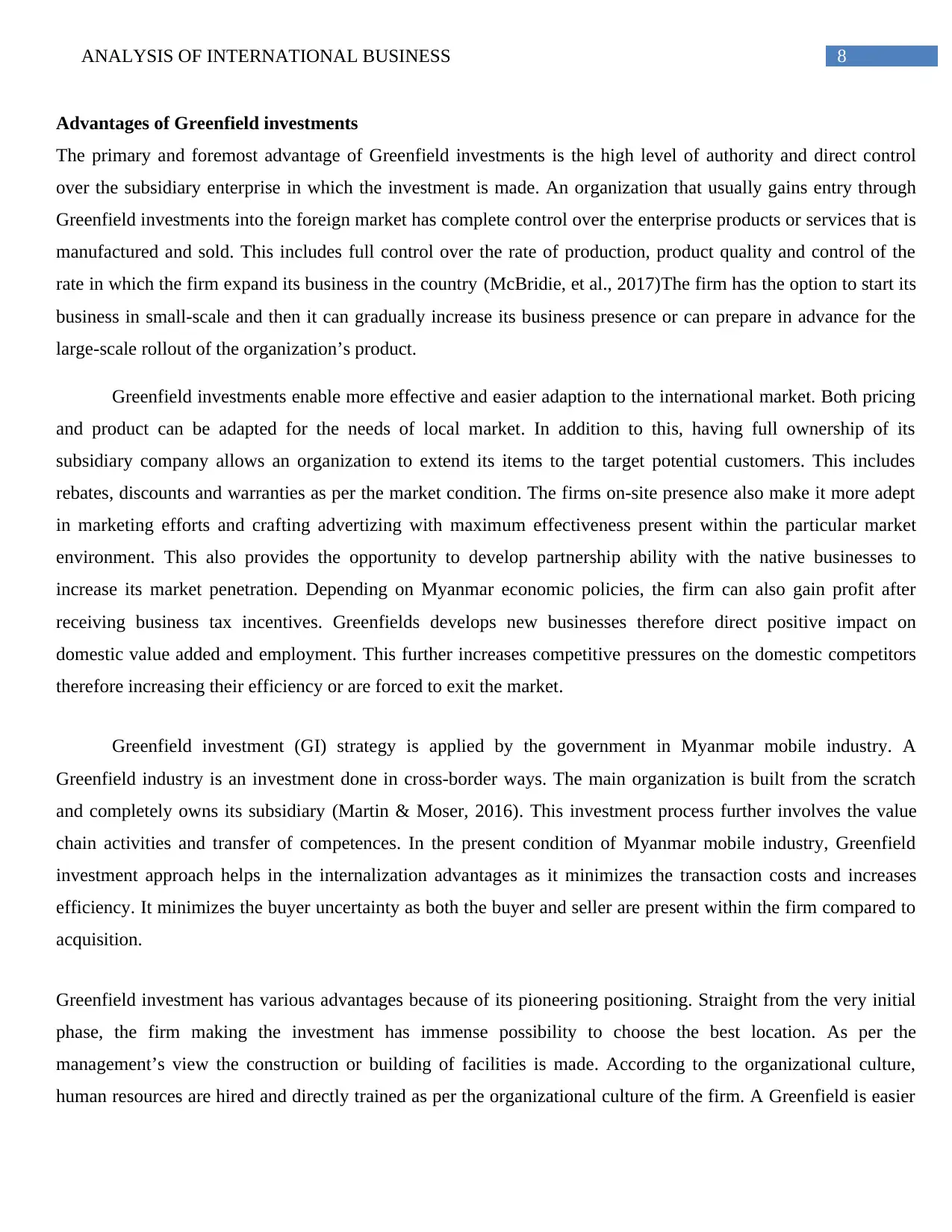
8ANALYSIS OF INTERNATIONAL BUSINESS
Advantages of Greenfield investments
The primary and foremost advantage of Greenfield investments is the high level of authority and direct control
over the subsidiary enterprise in which the investment is made. An organization that usually gains entry through
Greenfield investments into the foreign market has complete control over the enterprise products or services that is
manufactured and sold. This includes full control over the rate of production, product quality and control of the
rate in which the firm expand its business in the country (McBridie, et al., 2017)The firm has the option to start its
business in small-scale and then it can gradually increase its business presence or can prepare in advance for the
large-scale rollout of the organization’s product.
Greenfield investments enable more effective and easier adaption to the international market. Both pricing
and product can be adapted for the needs of local market. In addition to this, having full ownership of its
subsidiary company allows an organization to extend its items to the target potential customers. This includes
rebates, discounts and warranties as per the market condition. The firms on-site presence also make it more adept
in marketing efforts and crafting advertizing with maximum effectiveness present within the particular market
environment. This also provides the opportunity to develop partnership ability with the native businesses to
increase its market penetration. Depending on Myanmar economic policies, the firm can also gain profit after
receiving business tax incentives. Greenfields develops new businesses therefore direct positive impact on
domestic value added and employment. This further increases competitive pressures on the domestic competitors
therefore increasing their efficiency or are forced to exit the market.
Greenfield investment (GI) strategy is applied by the government in Myanmar mobile industry. A
Greenfield industry is an investment done in cross-border ways. The main organization is built from the scratch
and completely owns its subsidiary (Martin & Moser, 2016). This investment process further involves the value
chain activities and transfer of competences. In the present condition of Myanmar mobile industry, Greenfield
investment approach helps in the internalization advantages as it minimizes the transaction costs and increases
efficiency. It minimizes the buyer uncertainty as both the buyer and seller are present within the firm compared to
acquisition.
Greenfield investment has various advantages because of its pioneering positioning. Straight from the very initial
phase, the firm making the investment has immense possibility to choose the best location. As per the
management’s view the construction or building of facilities is made. According to the organizational culture,
human resources are hired and directly trained as per the organizational culture of the firm. A Greenfield is easier
Advantages of Greenfield investments
The primary and foremost advantage of Greenfield investments is the high level of authority and direct control
over the subsidiary enterprise in which the investment is made. An organization that usually gains entry through
Greenfield investments into the foreign market has complete control over the enterprise products or services that is
manufactured and sold. This includes full control over the rate of production, product quality and control of the
rate in which the firm expand its business in the country (McBridie, et al., 2017)The firm has the option to start its
business in small-scale and then it can gradually increase its business presence or can prepare in advance for the
large-scale rollout of the organization’s product.
Greenfield investments enable more effective and easier adaption to the international market. Both pricing
and product can be adapted for the needs of local market. In addition to this, having full ownership of its
subsidiary company allows an organization to extend its items to the target potential customers. This includes
rebates, discounts and warranties as per the market condition. The firms on-site presence also make it more adept
in marketing efforts and crafting advertizing with maximum effectiveness present within the particular market
environment. This also provides the opportunity to develop partnership ability with the native businesses to
increase its market penetration. Depending on Myanmar economic policies, the firm can also gain profit after
receiving business tax incentives. Greenfields develops new businesses therefore direct positive impact on
domestic value added and employment. This further increases competitive pressures on the domestic competitors
therefore increasing their efficiency or are forced to exit the market.
Greenfield investment (GI) strategy is applied by the government in Myanmar mobile industry. A
Greenfield industry is an investment done in cross-border ways. The main organization is built from the scratch
and completely owns its subsidiary (Martin & Moser, 2016). This investment process further involves the value
chain activities and transfer of competences. In the present condition of Myanmar mobile industry, Greenfield
investment approach helps in the internalization advantages as it minimizes the transaction costs and increases
efficiency. It minimizes the buyer uncertainty as both the buyer and seller are present within the firm compared to
acquisition.
Greenfield investment has various advantages because of its pioneering positioning. Straight from the very initial
phase, the firm making the investment has immense possibility to choose the best location. As per the
management’s view the construction or building of facilities is made. According to the organizational culture,
human resources are hired and directly trained as per the organizational culture of the firm. A Greenfield is easier
⊘ This is a preview!⊘
Do you want full access?
Subscribe today to unlock all pages.

Trusted by 1+ million students worldwide
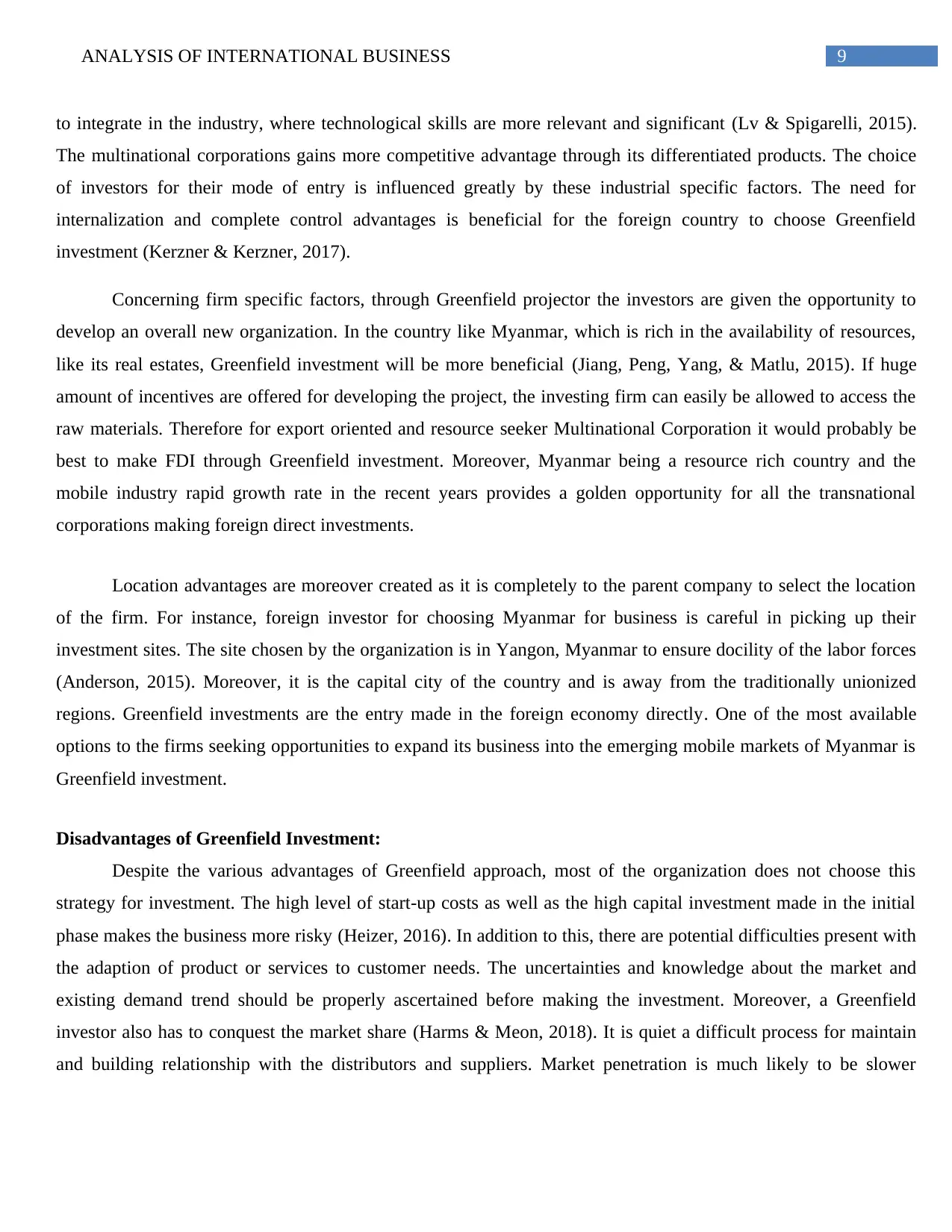
9ANALYSIS OF INTERNATIONAL BUSINESS
to integrate in the industry, where technological skills are more relevant and significant (Lv & Spigarelli, 2015).
The multinational corporations gains more competitive advantage through its differentiated products. The choice
of investors for their mode of entry is influenced greatly by these industrial specific factors. The need for
internalization and complete control advantages is beneficial for the foreign country to choose Greenfield
investment (Kerzner & Kerzner, 2017).
Concerning firm specific factors, through Greenfield projector the investors are given the opportunity to
develop an overall new organization. In the country like Myanmar, which is rich in the availability of resources,
like its real estates, Greenfield investment will be more beneficial (Jiang, Peng, Yang, & Matlu, 2015). If huge
amount of incentives are offered for developing the project, the investing firm can easily be allowed to access the
raw materials. Therefore for export oriented and resource seeker Multinational Corporation it would probably be
best to make FDI through Greenfield investment. Moreover, Myanmar being a resource rich country and the
mobile industry rapid growth rate in the recent years provides a golden opportunity for all the transnational
corporations making foreign direct investments.
Location advantages are moreover created as it is completely to the parent company to select the location
of the firm. For instance, foreign investor for choosing Myanmar for business is careful in picking up their
investment sites. The site chosen by the organization is in Yangon, Myanmar to ensure docility of the labor forces
(Anderson, 2015). Moreover, it is the capital city of the country and is away from the traditionally unionized
regions. Greenfield investments are the entry made in the foreign economy directly. One of the most available
options to the firms seeking opportunities to expand its business into the emerging mobile markets of Myanmar is
Greenfield investment.
Disadvantages of Greenfield Investment:
Despite the various advantages of Greenfield approach, most of the organization does not choose this
strategy for investment. The high level of start-up costs as well as the high capital investment made in the initial
phase makes the business more risky (Heizer, 2016). In addition to this, there are potential difficulties present with
the adaption of product or services to customer needs. The uncertainties and knowledge about the market and
existing demand trend should be properly ascertained before making the investment. Moreover, a Greenfield
investor also has to conquest the market share (Harms & Meon, 2018). It is quiet a difficult process for maintain
and building relationship with the distributors and suppliers. Market penetration is much likely to be slower
to integrate in the industry, where technological skills are more relevant and significant (Lv & Spigarelli, 2015).
The multinational corporations gains more competitive advantage through its differentiated products. The choice
of investors for their mode of entry is influenced greatly by these industrial specific factors. The need for
internalization and complete control advantages is beneficial for the foreign country to choose Greenfield
investment (Kerzner & Kerzner, 2017).
Concerning firm specific factors, through Greenfield projector the investors are given the opportunity to
develop an overall new organization. In the country like Myanmar, which is rich in the availability of resources,
like its real estates, Greenfield investment will be more beneficial (Jiang, Peng, Yang, & Matlu, 2015). If huge
amount of incentives are offered for developing the project, the investing firm can easily be allowed to access the
raw materials. Therefore for export oriented and resource seeker Multinational Corporation it would probably be
best to make FDI through Greenfield investment. Moreover, Myanmar being a resource rich country and the
mobile industry rapid growth rate in the recent years provides a golden opportunity for all the transnational
corporations making foreign direct investments.
Location advantages are moreover created as it is completely to the parent company to select the location
of the firm. For instance, foreign investor for choosing Myanmar for business is careful in picking up their
investment sites. The site chosen by the organization is in Yangon, Myanmar to ensure docility of the labor forces
(Anderson, 2015). Moreover, it is the capital city of the country and is away from the traditionally unionized
regions. Greenfield investments are the entry made in the foreign economy directly. One of the most available
options to the firms seeking opportunities to expand its business into the emerging mobile markets of Myanmar is
Greenfield investment.
Disadvantages of Greenfield Investment:
Despite the various advantages of Greenfield approach, most of the organization does not choose this
strategy for investment. The high level of start-up costs as well as the high capital investment made in the initial
phase makes the business more risky (Heizer, 2016). In addition to this, there are potential difficulties present with
the adaption of product or services to customer needs. The uncertainties and knowledge about the market and
existing demand trend should be properly ascertained before making the investment. Moreover, a Greenfield
investor also has to conquest the market share (Harms & Meon, 2018). It is quiet a difficult process for maintain
and building relationship with the distributors and suppliers. Market penetration is much likely to be slower
Paraphrase This Document
Need a fresh take? Get an instant paraphrase of this document with our AI Paraphraser
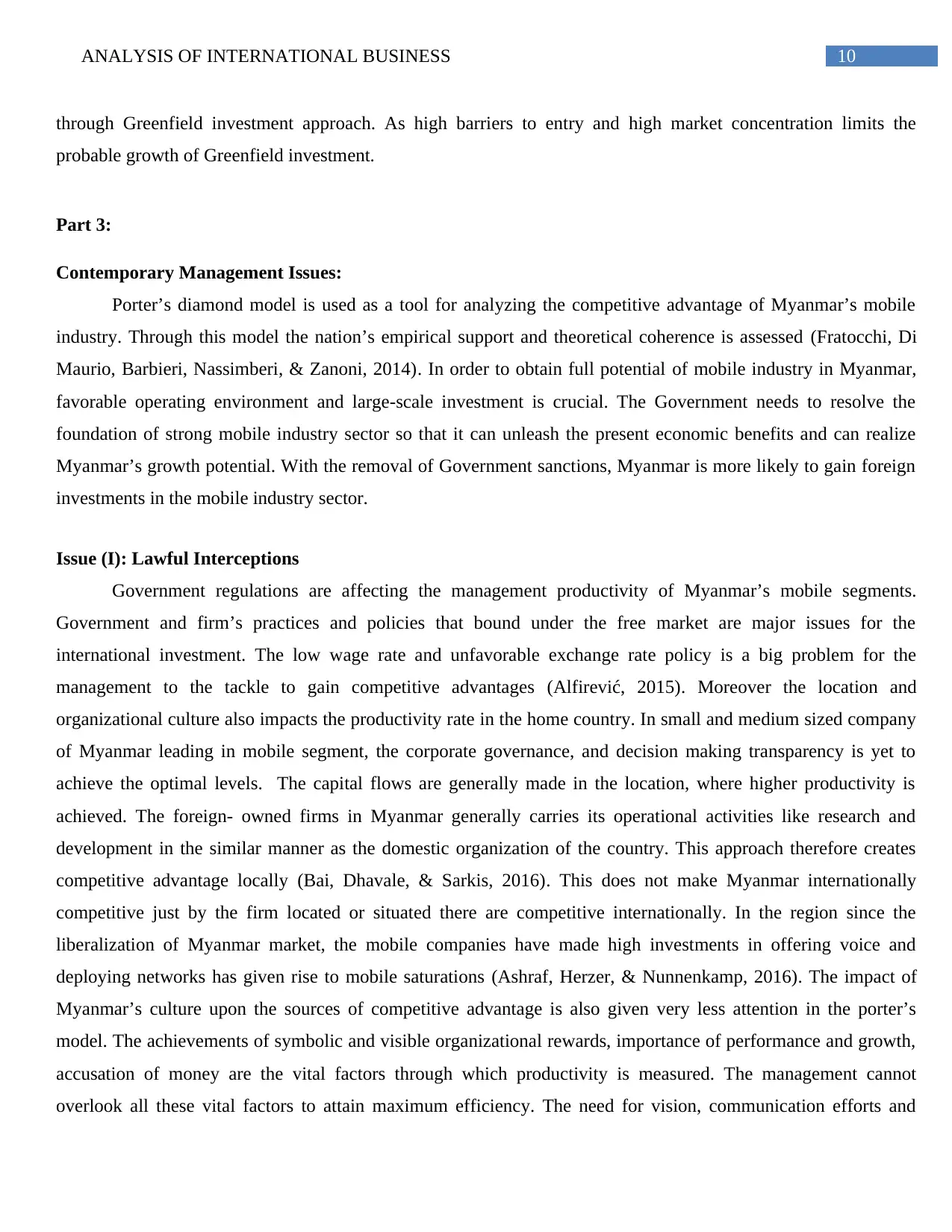
10ANALYSIS OF INTERNATIONAL BUSINESS
through Greenfield investment approach. As high barriers to entry and high market concentration limits the
probable growth of Greenfield investment.
Part 3:
Contemporary Management Issues:
Porter’s diamond model is used as a tool for analyzing the competitive advantage of Myanmar’s mobile
industry. Through this model the nation’s empirical support and theoretical coherence is assessed (Fratocchi, Di
Maurio, Barbieri, Nassimberi, & Zanoni, 2014). In order to obtain full potential of mobile industry in Myanmar,
favorable operating environment and large-scale investment is crucial. The Government needs to resolve the
foundation of strong mobile industry sector so that it can unleash the present economic benefits and can realize
Myanmar’s growth potential. With the removal of Government sanctions, Myanmar is more likely to gain foreign
investments in the mobile industry sector.
Issue (I): Lawful Interceptions
Government regulations are affecting the management productivity of Myanmar’s mobile segments.
Government and firm’s practices and policies that bound under the free market are major issues for the
international investment. The low wage rate and unfavorable exchange rate policy is a big problem for the
management to the tackle to gain competitive advantages (Alfirević, 2015). Moreover the location and
organizational culture also impacts the productivity rate in the home country. In small and medium sized company
of Myanmar leading in mobile segment, the corporate governance, and decision making transparency is yet to
achieve the optimal levels. The capital flows are generally made in the location, where higher productivity is
achieved. The foreign- owned firms in Myanmar generally carries its operational activities like research and
development in the similar manner as the domestic organization of the country. This approach therefore creates
competitive advantage locally (Bai, Dhavale, & Sarkis, 2016). This does not make Myanmar internationally
competitive just by the firm located or situated there are competitive internationally. In the region since the
liberalization of Myanmar market, the mobile companies have made high investments in offering voice and
deploying networks has given rise to mobile saturations (Ashraf, Herzer, & Nunnenkamp, 2016). The impact of
Myanmar’s culture upon the sources of competitive advantage is also given very less attention in the porter’s
model. The achievements of symbolic and visible organizational rewards, importance of performance and growth,
accusation of money are the vital factors through which productivity is measured. The management cannot
overlook all these vital factors to attain maximum efficiency. The need for vision, communication efforts and
through Greenfield investment approach. As high barriers to entry and high market concentration limits the
probable growth of Greenfield investment.
Part 3:
Contemporary Management Issues:
Porter’s diamond model is used as a tool for analyzing the competitive advantage of Myanmar’s mobile
industry. Through this model the nation’s empirical support and theoretical coherence is assessed (Fratocchi, Di
Maurio, Barbieri, Nassimberi, & Zanoni, 2014). In order to obtain full potential of mobile industry in Myanmar,
favorable operating environment and large-scale investment is crucial. The Government needs to resolve the
foundation of strong mobile industry sector so that it can unleash the present economic benefits and can realize
Myanmar’s growth potential. With the removal of Government sanctions, Myanmar is more likely to gain foreign
investments in the mobile industry sector.
Issue (I): Lawful Interceptions
Government regulations are affecting the management productivity of Myanmar’s mobile segments.
Government and firm’s practices and policies that bound under the free market are major issues for the
international investment. The low wage rate and unfavorable exchange rate policy is a big problem for the
management to the tackle to gain competitive advantages (Alfirević, 2015). Moreover the location and
organizational culture also impacts the productivity rate in the home country. In small and medium sized company
of Myanmar leading in mobile segment, the corporate governance, and decision making transparency is yet to
achieve the optimal levels. The capital flows are generally made in the location, where higher productivity is
achieved. The foreign- owned firms in Myanmar generally carries its operational activities like research and
development in the similar manner as the domestic organization of the country. This approach therefore creates
competitive advantage locally (Bai, Dhavale, & Sarkis, 2016). This does not make Myanmar internationally
competitive just by the firm located or situated there are competitive internationally. In the region since the
liberalization of Myanmar market, the mobile companies have made high investments in offering voice and
deploying networks has given rise to mobile saturations (Ashraf, Herzer, & Nunnenkamp, 2016). The impact of
Myanmar’s culture upon the sources of competitive advantage is also given very less attention in the porter’s
model. The achievements of symbolic and visible organizational rewards, importance of performance and growth,
accusation of money are the vital factors through which productivity is measured. The management cannot
overlook all these vital factors to attain maximum efficiency. The need for vision, communication efforts and
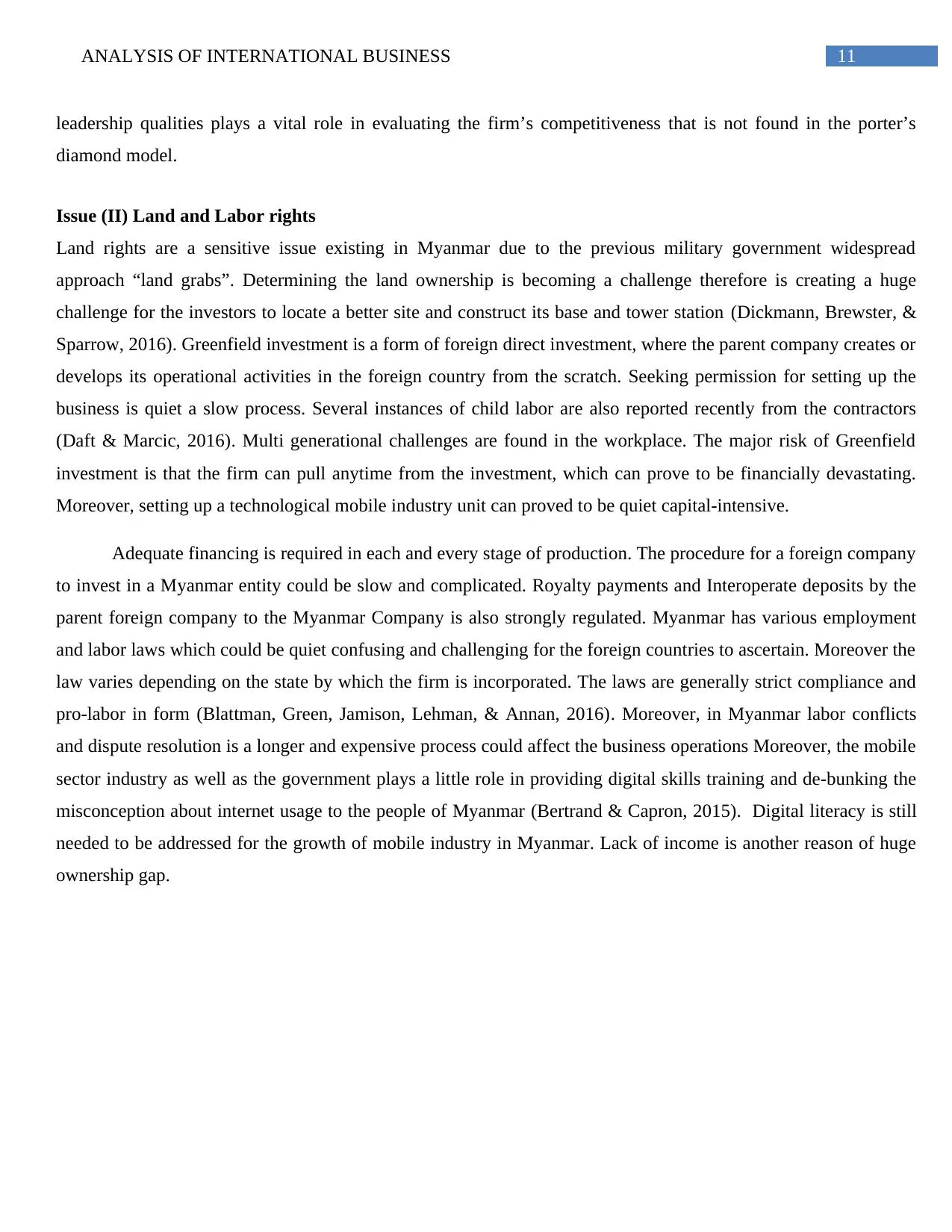
11ANALYSIS OF INTERNATIONAL BUSINESS
leadership qualities plays a vital role in evaluating the firm’s competitiveness that is not found in the porter’s
diamond model.
Issue (II) Land and Labor rights
Land rights are a sensitive issue existing in Myanmar due to the previous military government widespread
approach “land grabs”. Determining the land ownership is becoming a challenge therefore is creating a huge
challenge for the investors to locate a better site and construct its base and tower station (Dickmann, Brewster, &
Sparrow, 2016). Greenfield investment is a form of foreign direct investment, where the parent company creates or
develops its operational activities in the foreign country from the scratch. Seeking permission for setting up the
business is quiet a slow process. Several instances of child labor are also reported recently from the contractors
(Daft & Marcic, 2016). Multi generational challenges are found in the workplace. The major risk of Greenfield
investment is that the firm can pull anytime from the investment, which can prove to be financially devastating.
Moreover, setting up a technological mobile industry unit can proved to be quiet capital-intensive.
Adequate financing is required in each and every stage of production. The procedure for a foreign company
to invest in a Myanmar entity could be slow and complicated. Royalty payments and Interoperate deposits by the
parent foreign company to the Myanmar Company is also strongly regulated. Myanmar has various employment
and labor laws which could be quiet confusing and challenging for the foreign countries to ascertain. Moreover the
law varies depending on the state by which the firm is incorporated. The laws are generally strict compliance and
pro-labor in form (Blattman, Green, Jamison, Lehman, & Annan, 2016). Moreover, in Myanmar labor conflicts
and dispute resolution is a longer and expensive process could affect the business operations Moreover, the mobile
sector industry as well as the government plays a little role in providing digital skills training and de-bunking the
misconception about internet usage to the people of Myanmar (Bertrand & Capron, 2015). Digital literacy is still
needed to be addressed for the growth of mobile industry in Myanmar. Lack of income is another reason of huge
ownership gap.
leadership qualities plays a vital role in evaluating the firm’s competitiveness that is not found in the porter’s
diamond model.
Issue (II) Land and Labor rights
Land rights are a sensitive issue existing in Myanmar due to the previous military government widespread
approach “land grabs”. Determining the land ownership is becoming a challenge therefore is creating a huge
challenge for the investors to locate a better site and construct its base and tower station (Dickmann, Brewster, &
Sparrow, 2016). Greenfield investment is a form of foreign direct investment, where the parent company creates or
develops its operational activities in the foreign country from the scratch. Seeking permission for setting up the
business is quiet a slow process. Several instances of child labor are also reported recently from the contractors
(Daft & Marcic, 2016). Multi generational challenges are found in the workplace. The major risk of Greenfield
investment is that the firm can pull anytime from the investment, which can prove to be financially devastating.
Moreover, setting up a technological mobile industry unit can proved to be quiet capital-intensive.
Adequate financing is required in each and every stage of production. The procedure for a foreign company
to invest in a Myanmar entity could be slow and complicated. Royalty payments and Interoperate deposits by the
parent foreign company to the Myanmar Company is also strongly regulated. Myanmar has various employment
and labor laws which could be quiet confusing and challenging for the foreign countries to ascertain. Moreover the
law varies depending on the state by which the firm is incorporated. The laws are generally strict compliance and
pro-labor in form (Blattman, Green, Jamison, Lehman, & Annan, 2016). Moreover, in Myanmar labor conflicts
and dispute resolution is a longer and expensive process could affect the business operations Moreover, the mobile
sector industry as well as the government plays a little role in providing digital skills training and de-bunking the
misconception about internet usage to the people of Myanmar (Bertrand & Capron, 2015). Digital literacy is still
needed to be addressed for the growth of mobile industry in Myanmar. Lack of income is another reason of huge
ownership gap.
⊘ This is a preview!⊘
Do you want full access?
Subscribe today to unlock all pages.

Trusted by 1+ million students worldwide
1 out of 17
Related Documents
Your All-in-One AI-Powered Toolkit for Academic Success.
+13062052269
info@desklib.com
Available 24*7 on WhatsApp / Email
![[object Object]](/_next/static/media/star-bottom.7253800d.svg)
Unlock your academic potential
Copyright © 2020–2025 A2Z Services. All Rights Reserved. Developed and managed by ZUCOL.




